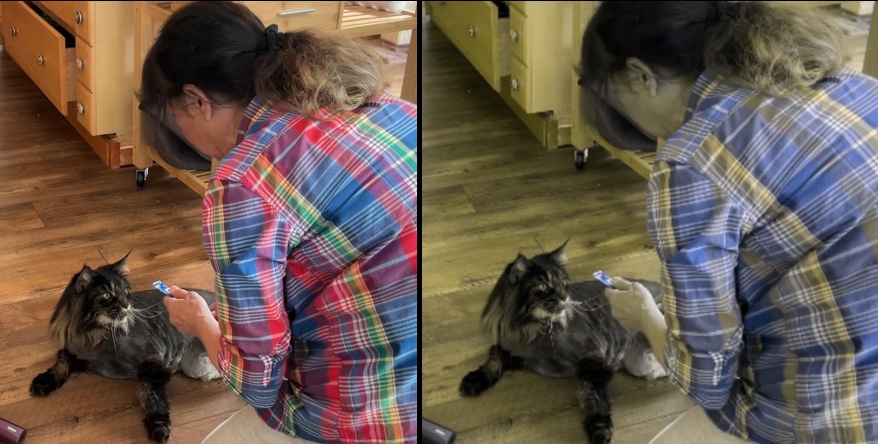
What my cat sees is different than what we humans see. Cats don’t share our discriminating color vision and are much more tuned into things that move quickly, like mice and birds. Cats have some color vision, see well in low light (Reference 1) and can recognize human facial expressions (Reference 2).
This post was originally published May 2020. It has been updated and new material added.
What my cat sees
the visual field
The visual field is how far up, down, left and right your eye sees when you’re staring at something. Cats have pretty large eyes for their size – they are almost as large as a human’s eyes. Like humans, they have front-facing eyes that gives them a large visual field in the front; there are two smaller fields on the side for each eye (peripheral vision) (Reference 1). They have a slightly larger field of vision than we do (200 degrees). If a cat were to lose an eye, their visual field drops by 30 degrees – they mainly lose some peripheral vision on the side of the missing eye.
what my cat sees – color vision
Humans have more “cone” cells in our retinas than cats do. Cone cells are responsible for color vision. The intensity of color vision is determined by the number of cone cells. The number of shades of color seen are due to the frequencies of light the cells absorb. We see 3 colors: red, blue and green. We have some cone cells that respond to red light, others that respond to blue light, and still others that respond to green light. Cats have cone cells that are sensitive to blue and yellow light, but not red or green light. A cat’s world is “faded” and “blurry” compared to ours, without the vibrant hues that we see. Take a look Here.
Motion Detecting
We can see that treat lying on the carpet partly because we are better at detecting different shades and hues of color than a cat is. If we toss the treat, the game changes, and kitty pounces on it. Cats are much better at detecting fast motion – cats’ eyes construct more than 60 visual images per second, which is 2x as fast as our human brains.
Closeup
Cats are not able to see things closer than about 25 cm or 10 inches. You may think this would handicap the cat when hunting but his super sense of smell and sensitive whiskers take over to hone in on that treat or mouse.
What my cat sees in the dark
Cats’ retinas have many more “rod” cells than cone cells. These cells are very sensitive to light and allow the cat to see well where there is not much light – around dawn and dusk, when cats are out hunting. The cat’s pupils can vary from slits to large dark circles, regulating the amount of light reaching the sensitive rod cells.
Ever noticed how your cat’s eyes seem to glow in the dark? The cat has another set of specialized cells in its eye. Behind the retina is the tapetum lucidum, a layer of cells that reflect light back through the retina so that the cones and rods have a second chance to process the light. This helps the cat see when there is not much light. Light shining into the pupils of the cat’s eyes will be reflected by the tapetum lucidum, giving the eerie “eye shine” of cats in the dark (Reference 1).
What my cat sees when he looks at me
Cats don’t have great visual resolution – what they see would look blurry to us. The tapetum lucidum causes light to scatter, reducing the sharpness of the image. Fewer cone cells also reduce visual resolution (Reference 1). In spite of these shortcomings, studies have shown that cats are able to recognize human emotions from facial and vocal expressions. Human volunteers were videoed smiling and laughing and also frowning and grumbling. Cats showed more stress-related behaviors when viewing “angry” recordings than “happy” ones (Reference 2).
What does this mean for you, the cat guardian?
- Greet your cat by extending a hand to him and saying his name, so that he can confirm who you are by scent and voice.
- Use toys that keep your hands and feet away from him. Don’t play games that have you moving quickly like a prey animal.
- Avoid staring directly at your cat – a direct stare between cats is often a distance-increasing message – one cat telling the other to back off. Instead, most cats appreciate a “slow blink” (for more about “slow-blinking” see “Look at Me – Cats Communicate by Gaze“).
Cats’ vision is well adapted to their role as hunters. They see well in the dawn and dusk conditions when their prey such as mice are most active. They are good at detecting motion which helps them spot prey. Their color vision is limited to blues and yellows but they still are able to identify human facial expressions, allowing them to communicate and bond with their human owners.
references
- Ofri, R.,Vision in Dogs and Cats, American Veterinarian®August 2018, Volume 3, Issue 6, August 17, 2018, https://www.dvm360.com/view/vision-in-dogs-and-cats, viewed 10/2024.
- Quaranta, A.; d’Ingeo, S.; Amoruso, R.; Siniscalchi, M. Emotion Recognition in Cats. Animals 2020, 10, 1107. https://doi.org/10.3390/ani10071107
- Takagi, S.; Arahori, M.; Chijiiwa, H.; Saito, A.; Kuroshima, H.; Fujita, K. Cats match voice and face: Cross-modal representation of humans in cats (Felis catus). Anim. Cogn. 2019, 22, 901–906.


